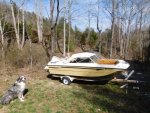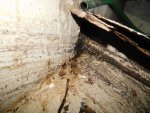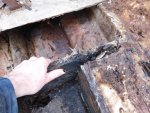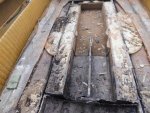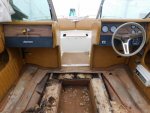Captndrydock
Petty Officer 3rd Class
- Joined
- Mar 9, 2020
- Messages
- 75
Hello I-boaters!
I recently purchased a 1977 Mark Twain, model 170T. Powered by a 135hp Chyrsler outboard. This is my first boat, so I have much to learn. I bought it knowing there was some rot, but once I got it home and inspected it further, discovered that the stringers are rotten mush from stern to bow. And I'll just go ahead and assume the transom is rotten as well. It doesn't sound out all too well and I can feel moisture where the stringers meet the transom.
I’m currently waiting for the former owner to get the title in his name and send it to me to register and title. I’ve just given him a down payment and expect to receive the title in the next few days. I’ve already cut out the decking, so that I can know what I’m working with and chopping at the bit to go further. But I’ve resolved to wait for the title.
In the meantime, I’m reading everything I can find on this boat and how to restore it, so that I’m ready to go, once it’s titled in my name. My plan is to remove the remaining interior parts and pieces, so that I can remove the cap. And then strip out the old stringers, replace them and then replace the transom.
For now , I have many lingering questions and was hoping to get some guidance on how to proceed and /or correct any ill conceived plans. Here are some of the questions I have:
Why are we using plywood for the stringers, instead of a rot resistant wood like locust, cedar or cypress?
The only thing I can figure is that plywood can be more stable. Or perhaps, if the shape of the stringer where it meets the transom is made taller, for more transom support. It might be hard to find a board that wide.(?)
Is marine grade plywood just plywood without voids? Would it be just as well to use 10 ply, hardwood core, cabinet grade plywood? This is typically cored with poplar wood. I could possibly find birch cored plywood. Or is there a reason marine grade plywood is superior for boating applications?
How much does a cap like the one photographed , typically weigh? I’ll need to learn more about how to remove it safely, so as not to damage it.
Will I need to remove the console and dash cluster or is there a way to suspend it, off to the side without disconnecting everything? Otherwise, I assume I’ll need to label all the wires, corresponding to the connections and photograph it thoroughly. Although, this particular aspect makes me nervous. Perhaps I should get the motor running before taking it all apart? Just so that I know it ran before dis-assembly. At least I would then know it’s my re- wiring that’s at fault.
I’ve been a carpenter for the last 35 years and I currently have a small cabinet shop, building and installing custom built-in furniture. I’ve also renovated several houses, so I have the skill set and tools to do this. But I don’t have knowledge in the specific techniques, so I’d really appreciate any insight anyone can add and I’m looking forward to getting this restoration under way. Thanks in advance!
I recently purchased a 1977 Mark Twain, model 170T. Powered by a 135hp Chyrsler outboard. This is my first boat, so I have much to learn. I bought it knowing there was some rot, but once I got it home and inspected it further, discovered that the stringers are rotten mush from stern to bow. And I'll just go ahead and assume the transom is rotten as well. It doesn't sound out all too well and I can feel moisture where the stringers meet the transom.
I’m currently waiting for the former owner to get the title in his name and send it to me to register and title. I’ve just given him a down payment and expect to receive the title in the next few days. I’ve already cut out the decking, so that I can know what I’m working with and chopping at the bit to go further. But I’ve resolved to wait for the title.
In the meantime, I’m reading everything I can find on this boat and how to restore it, so that I’m ready to go, once it’s titled in my name. My plan is to remove the remaining interior parts and pieces, so that I can remove the cap. And then strip out the old stringers, replace them and then replace the transom.
For now , I have many lingering questions and was hoping to get some guidance on how to proceed and /or correct any ill conceived plans. Here are some of the questions I have:
Why are we using plywood for the stringers, instead of a rot resistant wood like locust, cedar or cypress?
The only thing I can figure is that plywood can be more stable. Or perhaps, if the shape of the stringer where it meets the transom is made taller, for more transom support. It might be hard to find a board that wide.(?)
Is marine grade plywood just plywood without voids? Would it be just as well to use 10 ply, hardwood core, cabinet grade plywood? This is typically cored with poplar wood. I could possibly find birch cored plywood. Or is there a reason marine grade plywood is superior for boating applications?
How much does a cap like the one photographed , typically weigh? I’ll need to learn more about how to remove it safely, so as not to damage it.
Will I need to remove the console and dash cluster or is there a way to suspend it, off to the side without disconnecting everything? Otherwise, I assume I’ll need to label all the wires, corresponding to the connections and photograph it thoroughly. Although, this particular aspect makes me nervous. Perhaps I should get the motor running before taking it all apart? Just so that I know it ran before dis-assembly. At least I would then know it’s my re- wiring that’s at fault.
I’ve been a carpenter for the last 35 years and I currently have a small cabinet shop, building and installing custom built-in furniture. I’ve also renovated several houses, so I have the skill set and tools to do this. But I don’t have knowledge in the specific techniques, so I’d really appreciate any insight anyone can add and I’m looking forward to getting this restoration under way. Thanks in advance!




















